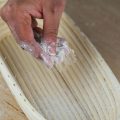During bulk fermentation, your dough needs to rest and proof at room temperature. But did you know that your dough can also proof at a colder temperature? Here’s an easy guide on how to cold proof sourdough.
![How To Cold Proof Sourdough [Your Easy Guide] 1 How to cold proof sourdough](https://www.mydailysourdoughbread.com/wp-content/uploads/2023/01/bread-stockpack-unsplash-720x480.jpg)
Table of Contents
- What is Proofing?
- Why Proof Sourdough In The Fridge?
- How Long to Proof Sourdough In Fridge?
- Why Does Temperature Matter When Proofing Sourdough?
- Cold Proofing Sourdough
- FAQs
What is Proofing?
In sourdough baking terms, proofing refers to the dough’s resting time. This usually occurs after shaping, and before baking.
Proofing can be done at room temperature, or overnight in the refrigerator, however, it’s very important that you don’t let the dough overproof.
Often, sourdough is cold-proofed, i.e., placed in a banneton, and refrigerated to rest before baking. While the yeast sleeps, the bacteria continue to work, providing sourdough with that delicious tang.
Why Proof Sourdough In The Fridge?
Most sourdough recipes have the option to proof at room temperature for 1-3 hours, or proof in the refrigerator overnight. Proofing in the refrigerator is often referred to as a cold retard, because it slows down the final rise.
Here are some additional reasons to cold-proof sourdough.
Better Flavor
Dough that has been cold retarded has a pronounced sour flavor, compared to room-temperature proofed dough.
When bread proofs at room temperature, the dough develops faster than the flavor, whereas dough that is cold-proofed has been given more time to envelop the dough in unique and tasteful flavors.
This is a result of the cold temperatures slowing down the yeast’s fermentation activity, though the bacteria in the starter don’t require a certain temperature to work their magic. They continue to break down the starches into lactic acid and acetic acids, providing the dough with that subtle, yet irresistible tang.
Easier to Handle
Cold dough is much easier to handle compared to room-temperature dough. Simply flip it out of the banneton to score, and you’ll find the blade glides through the cold dough perfectly.
The warm dough can flatten once it’s removed from the banneton. This limits your time for scoring and transferring the dough to the oven. The blade tends to stick into the warm dough which can be a problem.
Adds Flexibility
Proofing your dough in the fridge enables you to get on with the rest of your day, while the bacteria works its magic on your dough. Whereas dough that is proofed on the counter can finish proofing any time between 1-3 hours, which doesn’t give you much time to relax, as you’ll anxiously await the fate of your dough.
Better Crust And Crumb
Cold fermented dough tends to have an incredibly crisp crust and crumb, compared to sourdough proofed at room temperature.
If you’re looking for a deliciously browned crust that’s both crisp and plush at the same time, then cold-proofed dough is the way forward.
The crumb is so much better because the gluten develops overnight, and you needn’t use aggressive kneading to speed up the process.
![How To Cold Proof Sourdough [Your Easy Guide] 2 How to cold proof sourdough [your easy guide]](https://www.mydailysourdoughbread.com/wp-content/uploads/2023/01/blog-images-41-720x405.jpg)
How Long to Proof Sourdough In Fridge?
Cold proofing enables you to bake your sourdough at a time that is convenient for you, without having to worry about over-proofing.
A long, cold fermentation will increase the sourness of the bread, so having this in mind helps. You can proof sourdough in the fridge for up to 6 hours or longer if your dough can handle it.
However, you need to ensure that the dough doesn’t use up all of its energy before it gets to the oven. You may need to go through a bit of trial and error to find a cold-proofing period that works for you and the dough.
If you’re using whole grains or rye flour, they may not do as well as other types of flour when cold proofed like bread flour.
Whole grain and rye flour can be more sensitive to the acids in your starter, thus having a weaker gluten network which will break down easily.
How to Proof Sourdough in The Fridge?
- Follow the sourdough bread recipe, until you reach the final shaping stage.
- Shape the dough in a boule or batard, then place the shaped loaf into a banneton or other sourdough proofing basket.
- Cover the proofing basket with plastic wrap.
- Place the covered banneton in the fridge for as long as you intend.
- Once ready, preheat the oven and Dutch oven and bake the dough from the fridge.
Why Does Temperature Matter When Proofing Sourdough?
The dough temperature can affect how long you need to ferment your dough, as well as how the yeasts and bacteria consume the sugars. This will also affect the taste of the loaf.
Understanding how temperature affects the dough will enable you to have control over:
- How long you will ferment or proof the dough for.
- The final flavor of the bread.
With sourdough’s track record, we can understand that it tends to run on its own terms. So the more variables you can control, the more you’ll be able to predict the results of your final loaf.
The Effect of Temperature on Sourdough Fermentation
The sourdough starter has an array of bacteria and yeats. Various strains of yeasts and bacteria survive at alternating temperatures.
When yeasts are fermented effectively, they produce minimum byproducts, and these byproducts are what provide our loaves with such complex yet wonderful flavors.
Knowing this, we can attempt to manipulate the flavors of our bread.
Proofing Temperature
- Yeast tends to ferment best at 80°F-90°F. Given this desired dough temperature will have them consuming sugars from the dough, providing a mild flavor.
- The strains of bacteria ferment effectively outside of these temperatures, therefore affecting the flavor.
- At higher temperatures they produce lactic acid bacteria, which gives it a simple sour flavor.
- At lower temperatures, they produce acetic acid, which gives the dough a profound tang.
| Temperature Range | Fermentation Time | Flavor Outcome | |
| Hot (very hot sunny day) | 82F°-85°F (28°C-29°C) | Short (4-6 hours) | Base sourness |
| Warm (room temperature) | 70°F-75°F (21°C-24°C) | Medium (6-12 hours) | Mild |
| Cold (fridge temperature) | 35°F-5°0F (2°C-10°C) | Long (12-24+ hours) | Tangy sourness |
Cold Proofing Sourdough
Cold temperature works best when it comes to sourdough, especially if you’re looking for a more pronounced sourdough flavor.
For a detailed beginner guide, check out my beginner sourdough recipe.
FAQs
What Happens If You Don’t Cold Proof Sourdough?
Without cold proofing, the resultant loaf will be dense, with no rise in the oven.
Can You Overproof Sourdough in The Fridge?
It’s quite impossible to overproof sourdough in the refrigerator unless it has been left for days.
Can I Bake Sourdough Straight From The Fridge?
Yes, you can certainly bake with a sourdough starter straight from the fridge.
Can You Let Sourdough Proof Overnight?
Certainly. proofing sourdough overnight in the fridge is a great option, especially if you plan to bake it first thing in the morning.





![How To Stretch And Fold Sourdough [A Detailed Guide] 7 How to stretch and fold sourdough [a detailed guide]](https://www.mydailysourdoughbread.com/wp-content/uploads/2023/06/How-To-Stretch-And-Fold-Sourdough-120x120.jpg)